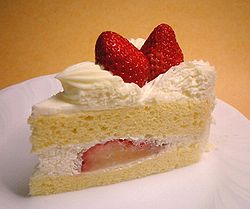
Back Soetheid Afrikaans حلاوة Arabic الحلاوه (تذوق) ARZ Hamis BCL Сладко (вкус) Bulgarian মিষ্টতা Bengali/Bangla Gust dolç Catalan شیرینی CKB Süßkraft German Γλυκύτητα Greek

Sweetness is a basic taste most commonly perceived when eating foods rich in sugars. Sweet tastes are generally regarded as pleasurable. In addition to sugars like sucrose, many other chemical compounds are sweet, including aldehydes, ketones, and sugar alcohols. Some are sweet at very low concentrations, allowing their use as non-caloric sugar substitutes. Such non-sugar sweeteners include saccharin, aspartame, sucralose and stevia. Other compounds, such as miraculin, may alter perception of sweetness itself.
The perceived intensity of sugars and high-potency sweeteners, such as aspartame and neohesperidin dihydrochalcone, are heritable, with gene effect accounting for approximately 30% of the variation.[1]
The chemosensory basis for detecting sweetness, which varies between both individuals and species, has only begun to be understood since the late 20th century. One theoretical model of sweetness is the multipoint attachment theory, which involves multiple binding sites between a sweetness receptor and a sweet substance.
Newborn human infants also demonstrate preferences for high sugar concentrations and prefer solutions that are sweeter than lactose, the sugar found in breast milk.[2][3] Sweetness appears to have the highest taste recognition threshold, being detectable at around 1 part in 200 of sucrose in solution. By comparison, bitterness appears to have the lowest detection threshold, at about 1 part in 2 million for quinine in solution.[4]
- ^ Hwang LD, Zhu G, Breslin PA, Reed DR, Martin NG, Wright MJ (2015). "A common genetic influence on human intensity ratings of sugars and high-potency sweeteners". Twin Res Hum Genet. 18 (4): 361–7. doi:10.1017/thg.2015.42. PMID 26181574.
- ^ Desor, J.A.; Maller, O.; Turner, R.E. (1973). "Taste acceptance of sugars by human infants". Journal of Comparative and Physiological Psychology. 84 (3): 496–501. doi:10.1037/h0034906. PMID 4745817.
- ^ Schiffman, Susan S. (2 June 1983). "Taste and smell in disease (Second of two parts)". The New England Journal of Medicine. 308 (22): 1337–43. doi:10.1056/NEJM198306023082207. PMID 6341845.
- ^ McAleer, N. (1985). The Body Almanac: Mind-boggling facts about today's human body and high-tech medicine. New York: Doubleday.